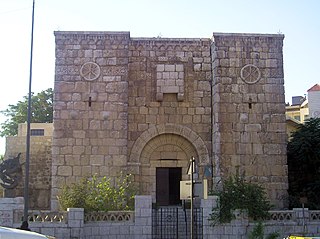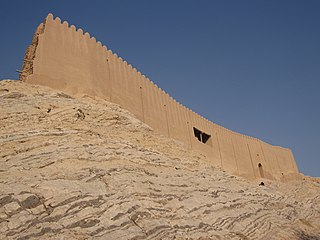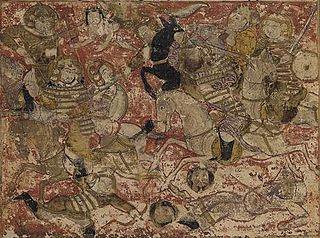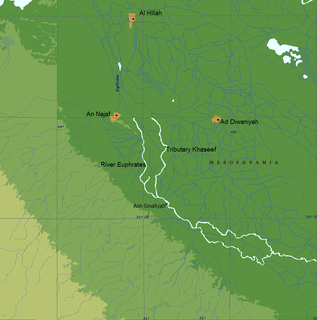 W
WBattle of Al-Anbar was between the Muslim Arab army under the command of Khalid ibn al-Walid and the Sasanian Empire. The battle took place at Anbar which is located approximately 80 miles from the ancient city of Babylon. Khalid besieged the Sassanian Persians in the city fortress, which had strong walls. Scores of Muslim archers were used in the siege. The Persian governor, Shirzad, eventually surrendered and was allowed to retire. The Battle of Al-Anbar is often remembered as the "Action of the Eye" since Muslim archers used in the battle were told to aim at the "eyes" of the Persian garrison.
 W
WThe Battle of al-Qadisiyyah also spelled Qadisiyah, Qadisiyya, Ghadesiyeh or Kadisiya, fought in 636, was a decisive battle between the Arab Muslim army and the army of the Sasanian Empire of Persia during the first period of Muslim conquests.
 W
WThe siege of Aleppo, the Byzantine stronghold and one of few remaining Byzantine castles in the northern Levant after the decisive Battle of Yarmouk, was laid between August and October 637.
 W
WForces of the Rashidun Caliphate seized the major Mediterranean port of Alexandria away from the Byzantine Empire in the middle of the 7th Century AD. Alexandria had been the capital of the Byzantine province of Egypt. This ended Eastern Roman maritime control and economic dominance of the Eastern Mediterranean and thus continued to shift geopolitical power further in favor of the Rashidun Caliphate.
 W
WThe Babylon Fortress, a major military stronghold of the Byzantine Empire in Egypt, was captured by forces of the Rashidun Caliphate after a prolonged siege in 640. It was a major event during the Muslim conquest of Egypt.
 W
WThe Battle of Bosra was fought in 634 between the Rashidun Caliphate army and the Byzantine Empire for the possession of Bosra, in Syria. The city, then capital of the Ghassanid Kingdom, a Byzantine vassal, was the first important one to be captured by the Islamic forces. The siege lasted between June and July 634.
 W
WThe Battle of the Bridge or the Battle of al-Jisr was a battle at the bank of the Euphrates river between Arab Muslims led by Abu Ubaid al-Thaqafi, and the Persian Sasanian forces led by Bahman Jaduya. It is traditionally dated to the year 634, and was the only major Sassanian victory over the Rashidun Caliphate army.
 W
WThe Battle of the Camel, also known as the Battle of Jamel or the Battle of Basra, took place at Basra, Iraq on 7 November 656. The battle was fought between Ali ibn Abi Talib, who was the cousin and son-in-law of the Islamic prophet, Muhammad, and A'isha, Talhah and Zubayr who led the campaign aiming to avenge the killing of the third caliph Uthman. Marking the second chapter of the First Fitna, the fateful battle ended with a victory for Ali. Naturally, the view of the event and the actors differs between the two major sects, Sunnis and Shias. The Sunnis hold that it was not the intention of either parties to engage in battle, and that the battle was an unforeseen consequence of interference from the rebels involved in the killing of Uthman. On the other hand, the Shia believe the killing of Uthman was a pretext for Aisha and her followers to wage war against Ali.
 W
WThe Battle of Sallasil or the Battle of Chains was the first battle fought between the Rashidun Caliphate and the Sasanian Persian Empire. The battle was fought in Kazima soon after the Ridda Wars were over and Eastern Arabia was united under the authority of Caliph Abu Bakr. It was also the first battle of the Rashidun Caliphate in which the Muslim army sought to extend its frontiers.
 W
WThe siege of Damascus (634) lasted from 21 August to 19 September 634 before the city fell to the Rashidun Caliphate. Damascus was the first major city of the Eastern Roman Empire to fall in the Muslim conquest of Syria.
 W
WThe Battle of Fahl, Battle of Pella or Battle of the Mud Arabic: معركة فحل was an Arab–Byzantine battle fought between the Rashidun army under Khalid ibn al-Walid Saifullah and the East Roman Empire under Theodore the Sacellarius (Saqalar), in Fahl in January 635 AD. The result was a clear victory for Khalid ibn al-Walid. Some Byzantine soldiers fled to Beisan. The Corps of Sharhabeel ibn Hasana and 'Amr ibn al-'As later captured the fortress of Beisan.
 W
WThe Battle of Firaz was the last battle of the Muslim Arab commander Khalid ibn al-Walid in Mesopotamia (Iraq) against the combined forces of the Byzantine Empire and the Sasanian Empire.
 W
WThe Battle of Heliopolis or Ayn Shams was a decisive battle between Arab Muslim armies and Byzantine forces for the control of Egypt. Though there were several major skirmishes after this battle, it effectively decided the fate of the Byzantine rule in Egypt, and opened the door for the Muslim conquest of the Byzantine Exarchate of Africa.
 W
WThe Battle of Hira was fought between the Sasanian Empire and the Rashidun Caliphate in 633. It was one of the early battles of the Muslim conquest of Persia, and the loss of the frontier city on the Euphrates River opened the way to the Sasanian capital at Ctesiphon on the Tigris River.
 W
WThe Battle of the Iron Bridge was fought between the Muslim Rashidun army and the Byzantine army in 637 AD. The battle took its name from a nearby nine-arch stone bridge spanning the Orontes River which had gates trimmed with iron. It was one of the last battles fought between the Byzantines and Rashidun Caliphate in the province of Syria. The aftermath of the battle marked the nearly complete annexation of the province into the Rashidun Caliphate with the fall of its capital.
 W
WThe siege of Jerusalem (636–637) was part of the Muslim conquest of the Levant and the result of the military efforts of the Rashidun Caliphate against the Byzantine Empire in the year 636–637/38. It began when the Rashidun army, under the command of Abu Ubaidah, besieged Jerusalem beginning in November 636. After six months, the Patriarch Sophronius agreed to surrender, on condition that he submit only to the Caliph. According to tradition, in 637 or 638, Caliph Umar traveled to Jerusalem in person to receive the submission of the city. The Patriarch thus surrendered to him.
 W
WBattle of Muzayyah was between the Muslim Arab army and the Sasanian Empire. When Khalid ibn Walid left from Ayn al-Tamr to Dumat Al-Jandal for the help of Iyad ibn Ghanm, the Persian court believed that Khalid had returned to Arabia with a large part of his army. The Persians decided to throw the Muslims back into the desert and regain the territories and the prestige which the Persian Empire had lost. The Persians had resolved not to fight Khalid again, but they were quite prepared to fight the Muslims without Khalid ibn al-Walid.
 W
WThe Battle of Nahavand, also spelled Nihavand or Nahawand, was fought in 642 between Arab Muslims under Umar and Sassanid armies. The battle is known to Muslims as the "Victory of Victories." The Sassanid King Yazdegerd III escaped to the Merv area, but was unable to raise another substantial army. It was a victory for the Rashidun Caliphate and the Persians consequently lost the surrounding cities including Spahan.
 W
WThe Battle of Nahrawan was fought between the army of Caliph Ali and the rebel group called Kharijites in July 658 CE. They were a group of pious allies of Ali during the First Muslim Civil War. They separated from him following the Battle of Siffin when Ali agreed to settle the dispute with Mu'awiya, governor of Syria, through negotiations, a move labeled by the group as against the Qur'an. After failed attempts to regain their loyalty and because of their rebellious and murderous activities, Ali confronted the Kharijites near their headquarters by the Nahrawan Canal, near modern-day Baghdad. Of the 4,000 rebels, some 1,200 were won over with promise of amnesty while majority of the remaining 2,800 were killed in the ensuing battle.
 W
WThe Battle of Nikiou was a battle between Arab Muslim troops under General Amr ibn al-A'as and the Byzantine Empire in Egypt in May of 646.
 W
WThe Battle of Rasil was fought between the Rashidun Caliphate and the Rai kingdom ruled by Raja Rasil in early 644. It was the first encounter of the Rashidun Caliphate in the Indian subcontinent. The exact location of the battle is not known, but historians suggest it was fought on the western bank of the River Indus.
 W
WThe Battle of Ray was fought between the Sasanians and the Rashidun Caliphate in 651. It was also part of the rivalry between the Ispahbudhan family and the Mihran family.
 W
WBattle of Saniyy was between the Muslim Arab army and the Sasanian Empire. When Khalid ibn Walid gone from Ayn al-Tamr to Dumat Al-Jandal for the help of Iyad ibn Ghanm, The Persian court believed that Khalid had returned to Arabia with a large part of his army, Persians decided to throw the Muslims back into the desert and regain the territories and the prestige which the Empire had lost. The Persians had resolved not to fight Khalid again, but they were quite prepared to fight the Muslims without Khalid ibn al-Walid. Khalid ibn al-Walid first defeated them at the battle of Muzayyah and then advanced towards Saniyy.
 W
WThe Siege of Shushtar was fought from 641 to 642 between the Sasanian Empire and the invading Arab Muslims of the Rashidun Caliphate. Shushtar was an ancient strong stronghold in Khuzestan, and was attacked by the Arabs under their commander Abu Musa Ashaari. Although the city managed to resist the Arabs, the Sasanians later faced desertion, which resulted in the Arabs capturing the city and capturing its commander, Hormuzan.
 W
WThe Battle of Siffin was the second battle of the First Fitna, after the Battle of the Camel. It was fought between Ali ibn Abi Talib, the fourth of the Rashidun caliphs, and Muawiyah I on the banks of the Euphrates river in Siffin around the present-day Syrian city of Raqqa. The armies had encamped at the site for more than two months prior to the battle and the offensive was finally launched by the Qurra' in Ali's army on July 26 and the battle lasted till July 28. The battle ended when the Syrian army was about to be routed but in a sudden turn of events both parties agreed to settle their conflict via arbitration.
 W
WThe Battle of Spahan was fought between the Rashidun Caliphate and the Sasanian Empire in 642. The Arabs were victorious during the battle, where they reportedly killed the Mihran commander Shahrvaraz Jadhuyih. After the battle, the Arabs made peace with Fadhusfan, the governor of the city. According to Abu No'aym, many people were killed or enslaved after the conquest and the settlement pattern of the region changed. Isfahan capitulated by 644 after a few failed revolts and treaties for paying taxes and tributes in exchange for military protection were drawn up.
 W
WThe Battle of Ullais was fought between the forces of the Rashidun Caliphate and the Sassanid Persian Empire in the middle of May 633 AD in Iraq, and is sometimes referred to as the Battle of Blood River since, as a result of the battle, there were enormous amounts of Sassanian and Arab Christian casualties.
 W
WThe Battle of Walaja was a battle fought in Mesopotamia (Iraq) in May 633 between the Rashidun Caliphate army under Khalid ibn al-Walid and Al-Muthanna ibn Haritha against the Sassanid Empire and its Arab allies. In this battle the Sassanid army is said to have been two times the size of the Muslim army.
 W
WThe Battle of the Yarmuk was a major battle between the army of the Byzantine Empire and the Muslim forces of the Rashidun Caliphate. The battle consisted of a series of engagements that lasted for six days in August 636, near the Yarmouk River, along what are now the borders of Syria–Jordan and Syria–Palestine, southeast of the Sea of Galilee. The result of the battle was a complete Muslim victory that ended Byzantine rule in Syria. The Battle of the Yarmuk is regarded as one of the most decisive battles in military history, and it marked the first great wave of early Muslim conquests after the death of Prophet Muhammad, heralding the rapid advance of Islam into the then-Christian Levant.
 W
WThe battle of Zumail was fought in 633 CE in Mesopotamia. It was a major Muslim victory in their conquest of that area. Under cover of night the Arab Muslims attacked the Christian-Arab forces, loyal to the Sasanian Empire, from three different sides. The Christian-Arab forces were unable to withstand the Muslim's surprise attack and soon dispersed but failed to escape from the battlefield and became the victims of a three sided attack by Khalid ibn al-Walid's army. At Zumail nearly the whole Christian Arab army was slaughtered by Khalid's Corps.